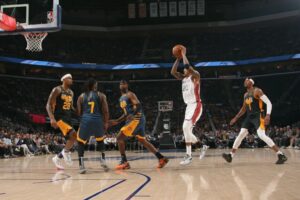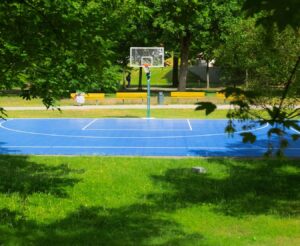Choosing the right pickleball paddle is crucial for both beginners and experienced players alike. With so many options on the market, it can be overwhelming trying to figure out which paddle is the best fit for your playing style and skill level.
Before making a decision, it is important to take into account a few key factors. In this article, we will guide you through the process of selecting a pickleball paddle, from understanding the different materials and features to finding the perfect weight and grip size.
Whether you are just starting or looking to upgrade your paddle, this guide will ensure that you choose the right one for your game.
Let’s look at how to choose a pickleball paddle.
Understanding the Importance of Choosing the Right Pickleball Paddle
Why is choosing the right pickleball paddle so important? The paddle you use can directly impact your performance on the court. Just like a tennis racquet, the paddle is your primary tool in the game of pickleball.

It can affect your control, power, and overall playing experience. So, it’s crucial to find the perfect paddle that suits your playing style and preferences. Now, you might be wondering how to choose a pickleball paddle. Don’t worry; Let’s explore some key factors to consider when selecting your ideal paddle.
1. Weight
Your overall performance is directly related to the weight of your pickleball paddle. Lighter paddles offer increased flexibility, allowing for quick reactions and better control. Alternatively, heavier paddles give you more power.
Paddles typically weigh between 7 and 8.5 ounces. If you’re looking for a lightweight option, paddles in the 7 to 7.6-ounce range are considered ideal. They offer a comfortable and easy-to-handle experience.
On the other hand, if you prefer a bit more heft and power in your paddle, you might want to consider a midweight option, which falls between 7.6 and 8.2 ounces. These paddles strike a balance between ease of use and power.
Lastly, if you’re after maximum power and stability, heavyweight paddles weighing more than 8.2 ounces are your best bet. Keep in mind that while these weight classifications are generally accepted, some brands may have slight variations in their ranges.
So, make sure to check the specific weight class offered by the brand you’re considering. Ultimately, choosing the right weight for your paddle is a personal preference that depends on your playing style and comfort.
Whether you go for a lightweight, midweight, or heavyweight paddle, the most important thing is to find one that feels right for you. In short, Choosing the right pickleball paddle can greatly impact your game and overall enjoyment on the pickleball court.
By considering factors such as weight, grip size, material, core, and shape, you can find a paddle that suits your playing style and helps you reach your full potential. Remember, it’s essential to try out different options and see what feels most comfortable and enhances your performance.
2. Grip Size
The grip size affects your ability to hold and maneuver pickleball paddle effectively. Having a grip that’s too small may lead to wrist discomfort and lack of control. Conversely, a grip that’s too large can cause your hand to fatigue quickly.
When it comes to grip size options, there are several to choose from. However, the majority of grip sizes fall between 3.875″ and 4.375″, with increments of 1/16″. Most players tend to opt for a pickleball paddle with a circumference of around 4 1/8″ to 4 3/8″.
In many cases, grips measuring 4 1/8″ are considered to be a safe choice since grip tape can increase volume if necessary. It’s important to understand the difference between a handle and a grip.
While these terms are often used interchangeably, they have distinct meanings when considering length and size. The handle length of a paddle refers to the grip from the jewel to the neck of the paddle, while the grip diameter measures the distance required to wrap around the handle.
3. Surface Material
While there are many materials available, the most common ones you’ll encounter are fiberglass, carbon fiber, and graphite. Let’s examine each of these materials in more detail. Fiberglass, which used to be the most popular choice, is still widely used today.
It is often referred to as composite, so don’t be confused if you come across this term. One of the key advantages of fiberglass is its power. Acting like a trampoline, it absorbs the energy from the ball and transfers it back, resulting in powerful shots.
However, due to its less stiff nature, the sweet spot on a fiberglass paddle is smaller compared to carbon fiber and graphite. Carbon fiber, on the other hand, is known for its superior feel.
Although it may not offer as much power as fiberglass, it provides a better sense of touch and control. Its stiffness allows the energy from the ball to be evenly distributed across the entire face and handle of the paddle, resulting in a larger sweet spot.
This enhanced feel comes at a slight cost in terms of power, as less energy is transferred back to the ball. Lastly, we have graphite, a type of carbon fiber that offers a more cost-effective solution for brands while delivering similar performance to a carbon fiber face.
Like carbon fiber, graphite provides an excellent feel and generates a comparable amount of power. In fact, during extensive paddle testing, it can be challenging to distinguish between a graphite and carbon fiber face.
4. Core
The core of a pickleball paddle refers to the material inside its face. Well, it is essentially the structural foundation of every pickleball paddle. It is typically constructed as a sheet of honeycomb shapes that is then placed between the two faces of the paddle.
The core plays a crucial role in determining the performance and characteristics of the paddle, so it’s important to understand the different materials and techniques used in its construction.
When it comes to the materials used for pickleball paddle cores, there are several options available. However, the two most commonly used materials are Nomex and polymer. Nomex is a material that consists of smaller but more numerous honeycombs compared to other composite core materials.
This unique structure increases the surface area of the core, resulting in a more rigid core. This rigidity allows Nomex cores to generate more power with each hit. On the other hand, polymer cores, also known as polycore or polypropylene cores, are the most popular choice among players today.
Polymer is a durable and flexible plastic material that provides a nice balance of power and control. It offers a comfortable feel and is suitable for players of all skill levels. If you’re a new player or simply looking for a reliable all-around paddle, a polymer core should be your default choice.
It’s important to note that the core material can greatly influence the overall performance and feel of the paddle. So, it’s worth considering you’re playing style and preferences when choosing a pickleball paddle with the right core material.
Core Thickness: Pickleball paddles come in various thicknesses, which is known as the core thickness. This refers to the depth of the paddle’s internal core, specifically the distance between the inside edges.
Typically measured in millimeters, paddle cores can range from around 11mm for thinner cores to close to 16mm for thicker cores. It’s worth noting that core thickness can also be expressed in inches, with 0.5 inches being roughly equivalent to 13mm, which is considered a medium core thickness.
By adjusting the core thickness in increments of 1/16th inch, you can achieve thinner or thicker cores. The core thickness of a pickleball paddle plays a crucial role in its performance.
A thicker core provides greater control during each hit by softening the impact of the ball when it makes contact with the paddle surface. On the other hand, a thinner core generates more power.
5. Paddle Shape
There are various shapes available for pickleball paddles, including the traditional one, the elongated paddle, and the widebody paddle. Let’s take a closer look at all of them.
1. Elongated Shapes: These paddles are longer, typically measuring around 16.5 inches in length and 7.5 inches in width.

While they offer more reach, power, and spin, they tend to have a smaller sweet spot and less maneuverability compared to other shapes. If you are confident in your accuracy and want to maximize your power shots, an elongated shape could be a great choice.
2. Classic Shapes: The original paddle shape; these paddles are usually about 16 inches long and 8 inches wide. They balance elongated and widebody shapes, providing a mix of power, spin, forgiveness, and maneuverability. If you are looking for an all-around paddle that offers versatility, a classic shape could be the right fit for you.

3. Widebody Shapes: These paddles have a wider face, approximately 8.5 inches, and a shorter length of around 15.5 inches. With a wide body shape, you can expect the largest sweet spot and high flexibility.

However, keep in mind that you may sacrifice reach and power compared to other paddle shapes. If you prioritize a larger sweet spot and quick maneuverability, a widebody shape might be the ideal choice.
6. Handle Length: Finding Your Grip
The length of the handle is another important factor to consider when choosing a pickleball paddle. Handle lengths can vary between 4.5 to 6 inches.
It’s essential to note that the total length of the paddle, including the handle, cannot exceed 24 inches due to regulations. Here’s how handling length impacts your gameplay.
1. Longer Handles: If you opt for a longer handle, ranging from 5.5 to 6 inches, you can generate more power and spin. This is because the longer handle provides you with greater leverage, allowing you to generate more force behind your shots. If you are an experienced player who wants to maximize power and spin, a longer handle could be advantageous.
2. Shorter Handles: On the other hand, shorter handles, typically around 4.5 to 5 inches, are preferred by lower-level players. These players tend to generate more power with shorter, wider paddles because they may not consistently hit the center of the paddle. A shorter handle provides more surface area on the paddle face, increasing the chances of hitting the ball effectively.
Ultimately, the choice of paddle face material comes down to personal preference and playing style. Fiberglass provides power, carbon fiber offers a better feel, and graphite is a cost-effective option that performs similarly to carbon fiber. So, go ahead and explore the options to find the perfect pickleball paddle that enhances your game.
Conclusion
choosing the right pickleball paddle is essential for enhancing your game and enjoying the sport to the fullest. By considering factors such as weight, grip size, material, and shape, you can find a paddle that suits your playing style and skill level.
Remember to try out different paddles and seek advice from experienced players to find the perfect fit for you. Whether you’re a beginner or a seasoned player, selecting the right pickleball paddle will undoubtedly contribute to your overall performance and enjoyment on the court.
FAQs
How Do I Know What Pickleball Paddle to Use?
Choosing the right pickleball paddle can depend on various factors, such as your playing style, grip preference, and skill level. To determine the best paddle for you, consider trying out different paddle weights, materials, and grip sizes.
It’s also helpful to seek advice from experienced players or consult with a local pickleball pro shop. Ultimately, finding the perfect paddle is a personal preference.
Is There Really a Difference in Pickleball Paddles?
Yes, there is indeed a difference in pickleball paddles. The variation lies in factors such as the material used, weight, grip size, and shape. These differences can affect the overall performance and feel of the paddle, allowing players to choose one that suits their playing style and preferences.
Is Graphite Better Than Composite?
Graphite and composite materials have their advantages and applications, so it really depends on the specific use case. Graphite is known for its lightweight and high-strength properties, making it ideal for applications where weight reduction is important, such as in aerospace or sports equipment.
On the other hand, composites offer a wider range of customizable properties, including strength, stiffness, and durability, making them suitable for various industries. Ultimately, the choice between graphite and composites will depend on the specific requirements and priorities of the project or application.









